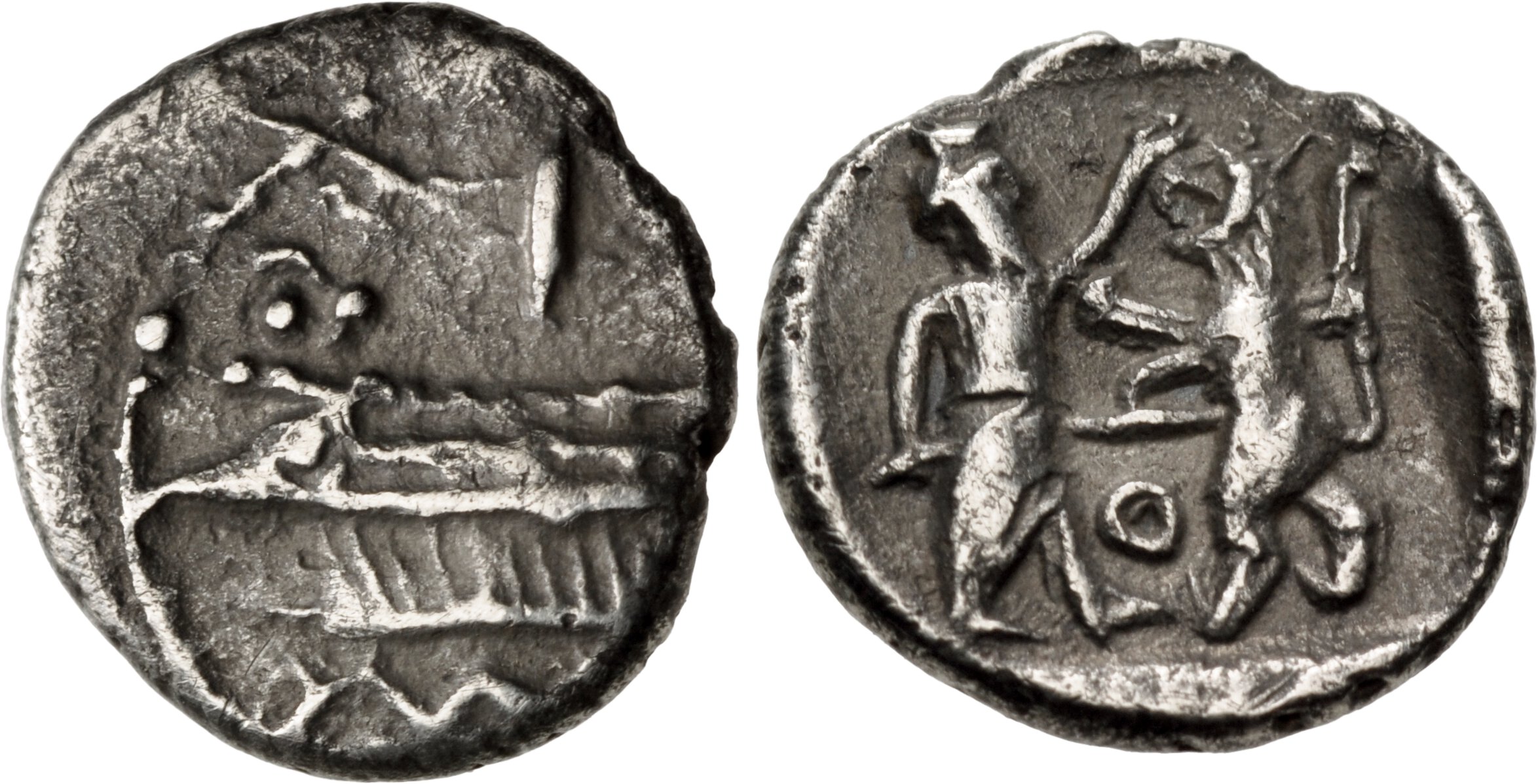Sidon (Tennes), silver, 16th shekels (351-347 BCE)
From SILVER
351 BCE - 347 BCE Silver 1,087 kg
Description
| ObverseInscription or printing placed on the obverse.: | (Phoenician).Phoenician galley left, 1 in Phoenician above, waves below |
| ReverseInscription or printing placed on the reverse.: | (Phoenician).Persian king or hero, holding dagger, standing right, fighting lion standing left on its hind legs, T' (in Phoenician) between, all within incuse square |
Mint and issuing power
| MintIdentifies the place of manufacture or issue of a numismatic object.: | Sidon | Ancient regionAncient region.: | Phoenicia | Modern countryModern country: Lebanon | AuthorityIdentifies the issuing power. The authority can be "pretended" when the name or the portrait of X is on the coin but he/she was not the issuing power. It can also be "uncertain" when there is no mention of X on the coin but he/she was the issuing power according to the historical sources: | Persian Empire, Tennes, king of Sidon (351-347 BCE) |
Chronology
| FromIdentifies the initial date in a range assigned in a numismatic context. | 351 BCE | toIdentifies the final date in a range assigned in a numismatic context.. | 347 BCE | PeriodTime period of the numismatic object.: Classical 480-323 BC |
Physical description
| MetalThe physical material (usually metal) from which an object is made.: | Silver |
Median weightMedian of the weights of numismatic objects (in grams). in grams | 0.70 | DenominationTerm indicating the value of a numismatic object. Examples: tetradrachm, chalkous, denarius.: | 16th shekel | StandardStandard.: | Phoenician |
Image

S1997 Sidon Tennes 16th shekel.jpg [1]
References
| Die study referencePublication of the study: | Elayi - Elayi 20041Elayi - Elayi 2004, p. 238-243, n° 1574-1626 (Group IV.3.2) | ||
| Coin series referenceReference to coin series study: | HGC 102HGC 10, n° 257 | ||
| Coin series web referenceCoin series web references: | |||
Obverse dies distribution
| FrequencyFrequency of specimen in distribution. ᵖ | Number of obversesNumber of obverse dies. ᵖ (o) | % (o) | Number of coinsNumber of coins. (n) | % (n) | Die nameName(s) of the die(s). |
| 1 | 14 | 87.5 | 14 | 73.68 | 1, 2, 3, 4, 5, 6, 7, 8, 9, 10, 12, 13, 15, 16 |
| 2 | 1 | 6.25 | 2 | 10.53 | 14 |
| 3 | 1 | 6.25 | 3 | 15.79 | 11 |
| Total | 16 of 16 | 100 | 19 of 19 | 100 |
Reverse dies distribution
no distribution is available
Quantification
| Number of obversesNumber of obverse dies. ᵖ (o) | 16 | Number of singletons (o1)The number of singleton coins. ᵖ | 14 |
| Number of reverse diesNumber of reverse dies. (r) | 19 | Number of coinsNumber of coins. (n) | 19 |
| Coins per obverse dieNumber of coins per obverse die. (n/o) | 1.19 | Coins per reverse dieNumber of coins per reverse die. (n/r) | 1 |
| Reverse per obverse ratioRatio of obverse dies divided by reverse dies. (r/o) | 1.19 | Percentage of singletons (o1)number of coins (n) divided by the number of singletons (o1) ᵖ | 87.5 % |
| Original number of dies (O) (Carter 1983 formula)The estimation of the number of coins according to Carter 1983 ᵖ | 77.67 | Coins struck if 20,000 as average productivity per dieCoins made if the average productivity for obverses (according to Carter) is 20,000. ᵖ | 1,553,400 |
| Original number of dies (O) (Esty 2011 formula)The estimation of the number of coins according to the singleton formula in Esty 2011 ᵖ (O) | 101.33 | Survival rate if 20,000 as average productivity per dieSurvival rate if average productivity is 20,000. ᵖ | 0.00001 |
| Coverage (o = % of O) (Esty 1984 formula)Esty 1984 - coverage (% of O) ᵖ (o = % of O) | 26.32% | Die productivity if survival rate 1/2,000Average productivity if survival rate is 1/2,000. ᵖ | 489.25 |
| Weight of silver (in kg) if 20,000 coins per die (O = Carter formula)Carter 1983 * Median weight * 20000 (*10 if gold or electrum) ᵖ | 1,087 kg <br /> 1,087 kg | Die productivity if survival rate 1/5,000Average productivity if survival rate is 1/5,000. ᵖ | 1,223.12 |
Remarks
Most likely one single workstation
References
- ^ Elayi, Josette - Elayi, Alain G. (2004), Le monnayage de la cité phénicienne de Sidon à l'époque perse (Ve-IVe s. av. J.-C.), Transeuphratène Suppl. 11, Paris, Gabalda, 2 v., 855 p., 77 pl.
- ^ Hoover, Oliver D. (2010), The Handbook of Greek Coinage Series. 10. handbook of coins of the Southern Levant : Phoenicia, southern Koile Syria (including Judaea), and Arabia, Lancaster-London, lxxix, 201 p.